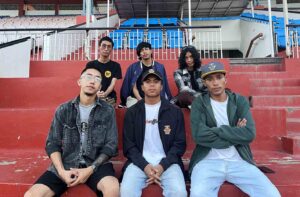In the culturally rich yet conservative state of Manipur, where traditional values often eclipse progressive artistic endeavors, the tribulations faced by performers dedicated to breakdancing have been particularly poignant. Breakdancing, or breaking as it’s often referred to, has long languished on the periphery of societal acceptance, dismissed as mere amusement for the masses. The prevailing public perception has been tainted by disdain, with many viewing it as a frivolous diversion rather than an art form deserving of reverence and recognition. This perception has been further compounded by the absence of governmental support, which has only solidified the belief that breaking is an unworthy pursuit—something to be momentarily enjoyed but never truly valued.
Nonetheless, amid this somber backdrop, the inclusion of breaking—often known as breakdancing, which originated in the Bronx, New York, during the 1970s as a core element of hip-hop culture—in the Paris 2024 Olympics has ignited a spark of hope among Manipur’s youth who have passionately devoted themselves to this craft. For these young artists, the Olympic recognition is not merely an acknowledgment of their skill; it is a profound affirmation of their identity and cultural expression. Their dreams, once stifled by societal indifference, now seem within reach, buoyed by the global recognition of their craft. Their eyes, once clouded by uncertainty, now gleam with the possibility of a future where their art is not just tolerated but celebrated on the world’s grandest stage.
In Paris 2024, Japan triumphed with gold in the women’s competition, while Canada claimed the pinnacle of success in the men’s event, setting a powerful precedent for the global acceptance and recognition of breaking as a serious sport. For the breakers in Manipur, these victories serve as both an inspiration and a challenge, fueling their resolve to ascend to similar heights.
In an exclusive interview with Imphal Review of Arts and Politics, energetic b-boys from Imphal, Manipur, elucidated their aspirations and shared the myriad struggles they have faced, along with the public’s disapproval of their efforts. They conveyed that, whatever the future may hold, their hopes remain lofty. Even if they themselves may not realize their ultimate dreams, they believe that the emerging generation of B-Boys and B-Girls will at least attain the recognition they so richly deserve. This sentiment underscores a profound shift in their perspective—from one of frustration to one of cautious optimism.
The momentous decision by the Olympics has the potential to recalibrate the narrative surrounding breaking, not just in Manipur but across the globe. It symbolizes a seismic shift in the way the world perceives street culture—a transformation of breaking from a misunderstood and marginalized activity into a respected and revered sport. For the breakers of Manipur, this is more than just an opportunity for personal glory; it is a chance to rewrite the story of their art form, to elevate it from the streets to the global arena.
However, this newfound hope is tempered by uncertainty. Will the Government of Manipur, long indifferent to the aspirations of these performers, finally step up to support them? Will society, which has so often dismissed their efforts, begin to perceive them in a new light? The answers to these questions remain to be seen. What is certain, however, is that the Paris Olympics have endowed these young dancers with something invaluable—a reason to believe that their struggle for recognition and respect is not in vain. The world is watching, and the stage is set for Manipur’s breakers to finally emancipate themselves from the shackles of societal prejudice and dance their way into history.
As the global stage begins to acknowledge the artistry of breaking, the voices of Manipur’s B-Boys resonate with renewed vigor and hope. In the following interview, these talented young dancers candidly share their experiences, aspirations, and the relentless challenges they face in their pursuit of passion. They open up about the societal disapproval that has long cast a shadow over their efforts, the struggles of carving out a space for themselves in a culture that often misunderstands them, and the deep sense of fulfillment they derive from their art.
Their words paint a vivid tapestry of the emotional and physical battles they’ve endured—fueled by an unwavering conviction that their art form is worthy of reverence and recognition. As they reflect on the inclusion of breaking in the Paris 2024 Olympics, their narratives are imbued with a delicate yet resolute optimism. They express a profound hope that, even if they do not achieve their ultimate dreams, the next generation of B-Boys and B-Girls will find a world more welcoming to their talents and efforts.
Manipur, a state renowned for consistently exceeding expectations, has produced a remarkable array of world-class athletes, despite its population constituting a mere 0.24 percent of India’s total in the 2011 census. The people of Manipur take immense pride in this legacy of excellence in sports, which stands as a testament to their resilience and indomitable spirit. Over the years, the state has transcended countless obstacles to achieve extraordinary feats on the global stage. The recent inclusion of breaking in the Olympics has now ignited a profound sense of hope among Manipur’s youth, who have fervently dedicated themselves to this dynamic and expressive dance form.

Sumit Sagolsem, 29, a multidisciplinary artist hailing from Khoyathong in Imphal West, is among those whose spirits have been invigorated by this momentous development. Sumit envisions a future where the dance community in Manipur receives the recognition it so richly deserves—not merely in the context of the Olympics but as an esteemed and integral part of the cultural mosaic. His excitement is palpable as he reflects on how the Olympic recognition has rekindled hope among breakers across the state, from Imphal to Ukhrul, Senapati, and beyond.
“The wave of breaking swept into Manipur around 2008, but we were bereft of designated spaces to practice, so we made do with whatever venues we could find—local community halls, courtyards, or any available space we could unearth,” Sumit recalls. “We would beseech people to allow us to use a space for an hour or two after their main work was done, and at times, we’d take to the streets. During the Yaoshang season, we would orchestrate street cyphers and flash mobs. But when we performed outside of festivals or occasions, the police would often intervene and halt our gatherings,” he adds.
Sumit articulates the deep-seated societal misconceptions that have long plagued breaking in Manipur. “People in our society often regard us with disdain, as if we’re merely intoxicated or squandering our time. They question what breaking could possibly yield for us, worrying about injuries or urging us to focus on earning money for the future. These are the refrains we’ve endured for years,” he explains. “In the past, our prospects seemed dim, but with the Olympic recognition, we finally have a reason to believe in our craft. It has also heightened public awareness that breaking is a pursuit of substance. While we still encounter struggles, they are not as overwhelming as before—some people have begun to acknowledge the value of our art.”
Sumit aspires to cultivate a flourishing dance community centered on breaking and its related styles, but he underscores that realizing this vision necessitates substantial financial support. “There are numerous events related to breaking occurring outside the state, but Manipur’s B-Boys and B-Girls often face insurmountable challenges in participating due to financial constraints. If the government were to provide funding or establish a scheme to support us, it would be transformative. In the past, because breaking lacked formal recognition, we were unable to approach the government or the public for assistance. But now, with the Olympics’ endorsement, we have the confidence to seek the help we need,” he says.
Philem Thomas, 25, from Sagolband Tera echoes this sentiment. Although his artistic journey did not begin with breaking, he has since devoted himself to the dance form with unwavering commitment. Thomas emphasizes the critical need for dedicated spaces for the breaking community in Manipur. “In Manipur, we have elders like B-Boy Waad, B-Boy Khaba, Vivek, and B-Boy Arrow, who have laid the groundwork for us. We are striving to follow in their footsteps and make our mark, but we are severely hindered by the lack of adequate spaces to practice. Some generous individuals allow us to use their premises, but it’s insufficient—we don’t have enough time to truly refine our skills,” Thomas explains.
He continues, “Just as sports like basketball, football, and hockey have their designated arenas at Khuman Lampak, we too require a space where we can hone our breaking skills and prepare to compete at the highest levels. The paucity of proper facilities has forced us to curtail our practice, stifling our potential. We urgently implore the government to formulate a policy that provides us with the necessary resources to grow and thrive.”

Pappu, 24, known in the breaking community as B-Boy Pappu, represents the resilient spirit of the Imphal Breakers, a crew that has carved out its own niche in the challenging world of b-boying since its inception in 2014. Over the years, Pappu and his crew have amassed an impressive array of titles, both within and beyond the borders of Manipur. Like Sumeet and Thomas, Pappu harbors a fervent hope to witness the rise of breaking as a recognized and celebrated art form in Manipur.
Reflecting on the early days, Pappu recalls how, in 2015, they formed a crew with Thomas and 28 other passionate individuals. There were several other crews apart from theirs, each with its own unique style and energy. However, a common struggle soon emerged: most of the breakers, including Pappu and his friends, did not come from affluent backgrounds. The need to juggle other jobs to earn a living while trying to improve their breaking skills proved to be an immense challenge. The lack of financial stability, coupled with the absence of adequate practice spaces and time, led to the dissolution of many crews. As interest waned and members dropped out, the original crew dwindled, prompting the formation of a new group—the Imphal Breakers. This new crew brought together individuals from various disbanded groups, united by their shared passion and determination.
Despite the adversities, the Imphal Breakers continued their journey, participating in local tournaments where they garnered accolades that bolstered their resolve. However, the road to recognition was far from smooth. “Since breaking is not popular in Manipur and few competitions were organized locally, we had to travel outside the state to compete,” Pappu explains. “Our first major win was in Gauhati, where we became the champions. We then traveled to Arunachal Pradesh and claimed victory there as well. In Shillong, we secured second place. From there, we ventured to cities like Mumbai, Kolkata, Bangalore, Delhi, and many other states across India.”
One of Pappu’s most significant achievements was competing in the India Final of the Red Bull BC One, the world’s most prestigious one-on-one B-Boy and B-Girl competition. Although he has yet to make it to the global stage, this experience underscored the potential that lies within the breaking community in Manipur. However, unlike athletes in more mainstream sports, breakers like Pappu have received little support from both the government and the public. The financial burden of traveling to competitions outside the state has largely fallen on their shoulders, a reality that has stifled the growth of many talented individuals.
“We face enormous financial problems,” Pappu candidly admits. “This is why we urge the government and the public to provide financial assistance or, at the very least, offer us space to practice. Organizing more competitions in Manipur or hosting events to select competitors for larger tournaments would also make a significant difference,” he added. Pappu’s plea is not just for himself but for the entire community of breakers in Manipur, who continue to persevere against all odds.
RK Bitesh, a seasoned dancer who has showcased his talent on grand stages like the Theatre Olympics, echoed the sentiment that the inclusion of breaking in the Olympics has indeed ignited a spark of hope within the dance community of Manipur. However, he stressed that this newfound hope must be met with tangible support from the government. “The entry of breaking into the Olympics is a monumental step, but for our community to truly flourish, we need comprehensive support from the government,” Bitesh asserted.
He elaborated on the critical need for government initiatives, including specific schemes and policies designed to propel dancers toward professional success. “To become a professional dancer, especially in a physically demanding style like breaking, there are numerous requirements—from proper nutrition to rigorous training regimens. Yet, we are consistently hindered by financial constraints,” he explained. “Maintaining good health and physical fitness is essential for anyone who wishes to excel in breaking, and without adequate support, these necessities become luxuries that many cannot afford.”
Bitesh urged government officials and bureaucrats to take decisive action and consider how they can help elevate dancers from Manipur to the global stage, including the Olympics. “It’s not just about breaking; the government must also recognize and invest in the broader culture that surrounds breakdance. This includes providing spaces for practice, organizing local competitions, and creating pathways for dancers to reach higher levels of recognition and success,” he added.
In Bitesh’s view, the government’s role is crucial not only in fostering talent but also in ensuring that the cultural heritage and artistic expression of breaking—and other dance forms—are preserved and promoted. “The potential is here, in our dancers, but it needs to be nurtured. If the government steps in with the right support, Manipur could very well see its breakers on the Olympic podium,” he concluded, underscoring the urgent need for action to match the aspirations of Manipur’s vibrant dance community.
All the breakers in Manipur harbor an ardent hope: that breaking will not merely subsist but indeed flourish within the confines of their state. They collectively beseech the government for the indispensable support required to transform this aspiration into reality. Among them, Lanchenba AK, an esteemed member of the Imphal Breakers, proffered his erudite opinion on how the government’s intervention could catalyze a renaissance of local talent.
Lanchenba articulated, with great perspicacity, that the orchestration of breaking events within Manipur, particularly those adjudicated by distinguished international judges, would substantially augment the proficiency and dexterity of the state’s breakers. “If the government could be persuaded to convene an event in Manipur at least once annually, and invite foreign judges to preside, it would be nothing short of transformative for us,” he proposed. “Even in the absence of external sponsorships, the mere opportunity to compete in state-sanctioned events would be of inestimable value. The pecuniary rewards from these competitions could, in turn, facilitate our participation in tournaments beyond the borders of the state,” he expounded.
Lanchenba underscored, with commendable sagacity, that the institution of regular breaking competitions in Manipur could serve as the crucible for a thriving dance community, one poised to produce individuals capable of attaining national and international renown. “If we were to institutionalize annual breaking competitions in Manipur, I am unequivocally convinced that this art form would not only endure but would indeed burgeon. Such a milieu would inevitably cultivate a cadre of prodigious talents, capable of bringing immense prestige to our state,” he asserted.
The collective aspirations of Manipur’s breakers are emblematic of a deeper yearning for recognition and institutional support—a resounding call for the government to invest in the untapped potential of its youth and the rich cultural fabric that breaking represents. With thoughtful encouragement, these dancers firmly believe that Manipur could rise to prominence as a hub of extraordinary talent, leaving an indelible mark not only on the national stage but on the global arena as well. The inclusion of breaking in the Olympics has ignited their hopes and dreams, yet the pressing question remains: Can Manipur’s breakers make it to the Olympics? The answer lies in the support of the people and, crucially, the much-needed attention and backing from the government.












